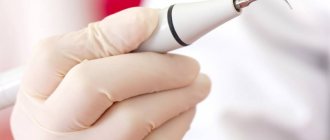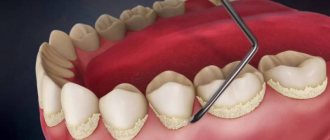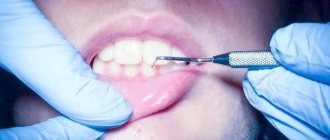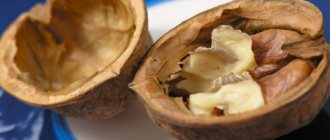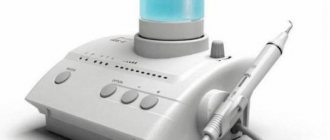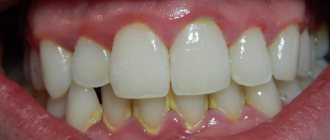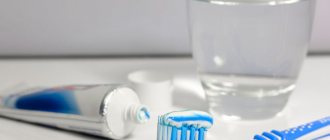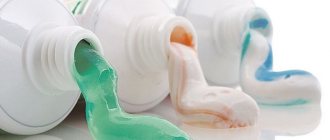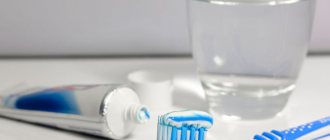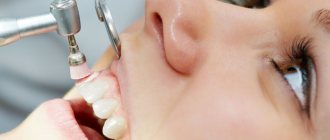Dental calculus is one of the most common pathologies. According to statistics, more than 65% of adults have it. Tartar should not be treated only as an aesthetic defect.
In addition to causing bad breath, tartar is the cause of many dental diseases and promotes infection in the body. Therefore, it is necessary to prevent stone formation, and if it forms, immediate treatment by a dentist.
What is tartar
Tartar is a hard, calcareous deposit on the surface of the tooth that is yellowish to dark brown in color. Initial plaque consists of food debris, dead cells, mucus and microorganisms. The stone is formed when soft plaque accumulates and thickens, and its gradual mineralization with calcium, phosphorus and iron salts. First, it forms in places where plaque accumulates the most: in the gingival zones, in the tooth sockets and in the interdental space. Most often on the inside of the dentition, where there is a hard-to-reach area for brushing teeth and the exit of the salivary gland canals. As the process progresses, it can cover the entire visible surface of the tooth and go under the gums.
Why does tartar form?
The appearance of tartar can occur for a number of reasons:
- Poor oral hygiene. First of all, you need to choose the right toothbrush - it should have bristles of different lengths and shapes. It is equally important to use a toothpaste that can effectively cope with plaque – it must have an abrasiveness index of at least 50 RDA.
- Unbalanced diet. Foods high in carbohydrates – flour, pasta, carbonated sweet water, etc. – provoke stone formation.
- Drinking strong black tea and smoking regularly. The latter is especially dangerous, since heated smoke intensifies the inflammatory process in the gums.
- Violation of pH levels. When it decreases, the acidity of saliva increases, as a result of which more minerals and salts are deposited on the surface of the teeth. If the level, on the contrary, increases, the acidity of saliva decreases, which affects the enamel, which becomes more loose.
- High content of fluoride and calcium in saliva. The ions of these components accelerate the formation of tartar.
- Uneven bite. The distance between crowns is a good place for plaque to accumulate.
- Orthopedic fixed structures in the mouth (plaque accumulates in the gaps between dentures and stones form).
- Thyroid diseases and diabetes. These diseases are accompanied by disruption of endocrine processes, which leads to changes in the acidity of saliva.
- The absence of several teeth, which affects chewing. If a person has no teeth on one side, he spontaneously begins to chew on the other side of his mouth. As a result, teeth do not undergo the natural self-cleaning procedure, so plaque accumulates on them.
- Too increased or, conversely, decreased production of saliva due to disturbances in the functioning of the salivary glands.
- The use of medications that affect the composition of saliva.
How quickly does a stone form?
The rate of stone formation varies from person to person and depends on hygiene skills and factors contributing to stone formation. In the absence of brushing your teeth, within a few hours after eating, a thick film of a huge number of bacteria feasting and multiplying on food debris forms on the surface of the tooth. After a week, the film thickens due to mineralization processes. On average, it takes about 4–6 months to form a dense stone. Therefore, a preventive examination by a dentist is necessary at least once every six months.
Modern method of cleaning teeth from tartar
Just a couple of decades ago, tartar was cleaned with a metal instrument - a curette.
Now there is a more effective method that is absolutely safe for tooth enamel: tartar is removed using ultrasound. The device for cleaning tartar is called an ultrasonic scaler.
Without even touching the teeth, it breaks deposits into small particles using ultrasonic vibrations of a certain frequency. Teeth are not only cleaned of tartar. It has been scientifically proven that ultrasound kills most bacteria. The duration of teeth cleaning from tartar depends on the amount of deposits. Usually it takes from 30 minutes to an hour. The procedure takes place without pain or discomfort. In rare cases, with increased tooth sensitivity or deep cleansing of periodontal pockets, local anesthesia is given.
Symptoms
Signs of tartar:
- using a mirror you can see dark deposits on the teeth near the gums (mostly on the inside), which do not disappear after hygiene procedures;
- darkening of tooth enamel;
- constant bad breath;
- bleeding gums when brushing teeth;
- increased gum sensitivity;
- deepening and widening of gum pockets, exposure of tooth roots.
Only supragingival plaques can be seen visually; subgingival formations are diagnosed by a doctor.
How to remove tartar quickly, efficiently and without pain
Poor oral hygiene leads to the formation of plaque, which hardens over time. This is called tartar. It is necessary to remove such deposits, as in the future they lead to global changes - bad breath appears, gums bleed and a person experiences pain or discomfort.
Methods for removing tartar
In terms of external manifestations, tartar is similar to incipient caries, but it is difficult to diagnose it at home. Plaque forms above the gum, forming a yellowish rim. After 3-6 months it completely hardens, and you can only get rid of it with the help of a specialist.
Removal in the clinic
There are several ways to get rid of tartar in the dental office:
- Chemical. In this case, removal is carried out using acidic and alkaline agents, which the dentist selects individually for each patient, based on the condition of the enamel and teeth in general. Concentrates enter into a chemical process with the mineralized film, soften and dissolve it.
- Ultrasound. The safest and non-contact method of destroying tartar, which uses a special ultrasonic device.
- Laser. Also a non-contact method, in which the beam acts on tartar, and a stream of water removes even the smallest deposits. Not the most popular option among patients due to its high cost.
- Air-Flow. The method is rarely used as an independent method of removing tartar. Usually, this technology only consolidates the result.
- Previously, mechanical cleaning was popular, using hammers. The mineralized deposits were broken up and then removed. Now medicine has stepped far forward, so the method is a thing of the past.
Removing a house
It is impossible to completely remove tartar at home without harming dental health. The process of formation and hardening of plaque is quite long, it is easier to prevent it with the help of high-quality oral hygiene. However, if such a problem does occur, you can resort to traditional methods of removing tartar.
There are not many safe and painless options:
- Special pastes with grinding and abrasive substances. This method is more preventative, as it is used only with minimal deposits. In addition, dentists do not recommend using such compositions too often, so as not to damage the enamel.
- Irrigator. The device delivers a jet of water under pressure, which can reach even the most remote corners of the oral cavity. The irrigator perfectly washes away deposits between teeth.
- Hydrogen peroxide. A simple remedy comes into chemical contact with calcium salts. The hardened plaque is softened and then removed with a regular brush. Peroxide should be used carefully, making a solution in a ratio of 1:3. This product should be applied to the enamel with a swab and held for no more than two minutes.
- Lemon juice. Lemons contain a lot of acids that do an excellent job of dissolving tartar. It is not recommended to use this product for people with thin and sensitive enamel.
It is worth considering that any folk or home remedy should not be used more than once a week. This will help avoid damage and destruction of the enamel. Removing tartar is a simple process, but it is best left to professionals. Moreover, it is still not possible to completely clean crowns of deposits at home. It is possible to only slightly reduce the formation and slow down the mineralization of plaque.
Why is tooth stone dangerous?
In addition to an aesthetic defect, tartar is a common cause of a repulsive putrid odor from the mouth. In addition, stone formation can provoke the development of severe dental diseases:
- caries;
- gingivitis;
- periodontitis;
- tooth loss.
The presence of stone deposits reduces the local immunity of the oral cavity, which increases the proliferation of bacteria and aggravates the manifestation of their pathogenic properties. The consequence of the activity of bacteria is the destruction of tooth enamel and the development of various inflammatory processes in the oropharynx. Subgingival stones destroy the connection between teeth and bone, causing them to loosen and fall out. With severely advanced processes, it is no longer possible to stop tooth loss.
Consequences of stones
If the stones are not removed, this can lead to:
- the appearance of bad breath (its cause is the vital activity of microorganisms that have settled on the surface of the teeth);
- the formation of caries (bacteria in the process of life produce hydrochloric acid, which corrodes the enamel, which contributes to the onset of decay);
- inflammation of the gums, their bleeding, which can subsequently result in periodontitis;
- diseases of the mucous membrane (accumulation of colonies of microbes on the teeth can lead to ulcers and erosions);
- worsening of existing diseases (diabetes, heart disease, etc.).
Causes of tartar
The formation of tartar is a consequence of:
- insufficient or improper oral hygiene;
- disorders of mineral metabolism in the body, which is often associated with the presence of chronic diseases or genetic predisposition.
Factors that contribute to the formation of tartar, subject to insufficient hygiene, include:
- defective position of teeth;
- roughness of the tooth surface, often due to the installation of low-quality filling material or insufficient polishing;
- presence of braces and dentures.
- preference in the diet for soft and carbohydrate foods;
- one-sided chewing;
- smoking;
- alcohol abuse;
- hypersalivation (secretion of large amounts of saliva);
- a general decrease in the body’s immunity and the presence of foci of chronic infection.
Prevention of tartar formation
Is it possible to prevent tartar from forming? This question is often asked to dentists by patients after dental plaque removal procedures. Alas, there are no technologies in dentistry that would help get rid of tartar once and for all, but prevention can be carried out to promote the formation of deposits in smaller quantities and slow down the rate of their formation.
Effective prevention of tartar formation will include the following measures:
1. Regular brushing of teeth with the correct movements and the right toothbrush and toothpaste. If you don’t know which brush and paste are right for you, the dental hygienists of our clinic in Moscow, “Aesthetica”, will help you find the answer to this question!
2. When brushing your teeth, be sure to use dental floss or special brushes to help remove plaque and food debris from the spaces between your teeth.
3. Buy irrigators that help remove plaque from the subgingival space.
4. Stop smoking, drinking alcohol frequently, reduce the amount of sweet foods in your diet, and eat solid foods.
To remove tartar in a timely manner, visit the dentist once every six months and carry out professional oral hygiene procedures.
Smokers' tartar
There are practically no heavy smokers who do not have tartar. Tar from tobacco smoke and soot deposit a yellow coating on tooth enamel. It is easier for food debris to stick to this plaque and for bacteria to multiply comfortably. Gradually, under the influence of both saliva and tobacco smoke, various salts are deposited in plaque and brown tartar is formed. In addition, tobacco smoke contains toxic substances and heavy metals, which trigger the process of detachment of the gingival margin from the teeth. Food is stuffed into the deep gaps and optimal conditions are created for the growth of colonies of pathogenic bacteria. A regular toothbrush does not sweep out pathological contents from such pockets. And bacteria eat away the connective tissue between teeth and bone, exposing their roots. A dangerous inflammatory disease – periodontitis – gradually develops. Tartar deposited under the gum does not give a chance for self-healing, but turns the disease into a chronic form. Combined with the effects of tartar and destruction of the connective tissue that anchors the teeth, the process of development of periodontitis in smokers proceeds 3 times faster than in non-smokers. This leads to rapid tooth loss. According to statistics, 80-year-old smokers have 2.5 times fewer teeth than non-smokers.
How to remove tartar
If the plaque has formed into stone, then it will no longer be possible to get rid of it with an ordinary brush.
Tartar cleaning in Krasnodar is the only effective way to eliminate deposits. The professional method involves the use of ultrasonic cleaning: removing tartar from all teeth takes about one hour, if we are talking about supragingival deposits. To eliminate subgingival stone, you will have to visit the doctor several times, if his qualifications are sufficient to carry out the procedure.
It is better to immediately contact a periodontist rather than a therapist. This is especially true for people suffering from periodontitis, since they may have stones in the resulting pockets. If it is necessary to clean tartar located above the gum level, then a dentist-therapist will also help.
The cost of tartar removal in our clinic is 3,500 rubles. This includes polishing the teeth with a brush and toothpaste. Polishing teeth using a PROPHY flex device (a mixture of water, compressed air and fine sodium bicarbonate powder - baking soda).
Prevention of stone deposits
Prevention of any disease is always cheaper than its treatment. This applies not only to the financial component, but also to the temporary and psychological component.
The most important thing in preventing dental diseases is proper oral hygiene.
How to brush your teeth
To prevent the formation of tartar, learn how to brush your teeth correctly:
- Movements when brushing your teeth should be “sweeping”, in the direction from the gums to the edge of the tooth.
- First brush your front teeth, then carefully treat the inner surface of the dentition.
- The chewing surface is cleaned with back-and-forth and circular movements. Don't forget about your wisdom teeth.
- The duration of cleaning should be at least 3 minutes. To do this, it is convenient to have an hourglass in the bathroom or to clean while listening to a certain musical composition.
- Brush your teeth at least twice a day. The first time is after breakfast, the second time after dinner. If you are prone to the formation of stones, brush your teeth additionally after each meal.
Choosing a toothbrush
Not everyone knows how important it is to choose the right brush. Listen to the experts:
- Choose a high-quality, medium-hard toothbrush, preferably with rubber blades, which increase the effectiveness of removing plaque and polishing teeth.
- Soft brushes are only suitable for children or during periods of bleeding and sore gums.
- Hard brushes can be used 1 or 2 times a week. They should not be used in places where the necks of the teeth are exposed, especially if the sawing cleaning is improper. This contributes to the formation of wedge-shaped defects.
- Don't forget to change your brush every month.
Interesting experiment!
American doctors conducted an experiment, the participants of which were divided into 5 groups.
The first group: brushed their teeth with regular brushes and expensive toothpaste for 1 minute.
Second group: brushed their teeth with regular brushes and expensive toothpaste for 5 minutes.
Third group: they brushed their teeth with regular brushes and cheap toothpaste for 5 minutes.
Fourth group: they tried to brush their teeth without a brush, by rubbing expensive toothpaste with their fingers.
Fifth group: brushed their teeth with regular brushes without toothpaste, but for at least 5 minutes.
The experiment lasted a week. Every day after the procedure, the cleanliness of the teeth was measured.
At the end of the week there were the following results (the more stars, the cleaner the teeth):
| Group number | Brushes | Paste | Cleaning time | Result |
| 1 | Regular | Expensive | 1 minutes | Bad result |
| 2 | Regular | Expensive | 5 minutes | Excellent result |
| 3 | Regular | Cheap | 5 minutes | Excellent result |
| 4 | Without brushes | Expensive | 5 minutes | No result |
| 5 | Regular | Without paste | 5 minutes | Good result |
Conclusion: it turned out that when brushing your teeth, the toothbrush and the time spent on the procedure are important. You can brush your teeth even without toothpaste; it will be much more effective than using toothpaste without a brush. And if you clean it correctly, there is almost no difference between expensive or cheap toothpaste.
Other hygiene rules
- For continuous use, use only therapeutic and prophylactic pastes from well-known companies. For people prone to the formation of stones, it is useful to periodically brush their teeth with abrasive whitening pastes, for example, 2 times a week.
- After each meal, thoroughly rinse your mouth with special elixirs, and if you don’t have them on hand, you can use plain water.
- Use floss (special thread) to remove plaque between teeth. Floss is used both after brushing your teeth and without it in the afternoon. However, do not make cutting movements (back and forth), so as not to damage the gums, the movements should be: up and down.
- After brushing your teeth, use special devices - irrigators, which, under the pressure of a stream of water, will clean all places that are difficult for a brush to reach from bacteria and food, and improve blood circulation in the gums and dental pulp. In addition, you can polish your teeth with a special irrigator attachment, then it will be more difficult for the stone to be deposited on smooth enamel. Today, irrigators are recognized by dentists as one of the most effective ways to prevent tartar.
- Quit smoking completely. Or, at worst, use electronic cigarettes, the vapor of which does not contain toxic substances and resins involved in the formation of stones.
- Get a preventive examination from your dentist at least once a year, and more often if indicated.
- Have your teeth professionally cleaned periodically.
Tartar removal - reviews
Krevedgo ParanOyedalnOye
https://www.baby.ru/blogs/post/355775451-229311596/
it doesn’t affect the enamel, but the procedure itself is not very pleasant... at least not very pleasant for me))) it’s not even as unpleasant for me to treat teeth as to remove stone... I do it once a year
Nataly-Natalia,
https://deti.mail.ru/forum/zdorove/zdorove_krasota_diety/chistka_zubov_ot_kamnja/?page=3
removing tartar is not painful; if done with ultrasound, it is rather unpleasant, but if you have periodontal disease, it will be very, very unpleasant; if you are afraid, ask for anesthesia. but keep in mind that according to standard VHI, anesthesia in this case is not feared. You will most likely have to pay at your own expense. and removing tartar for cosmetic purposes is often not a fear. read carefully what is written in your policy or better call the SK remote control so that it doesn’t come as a surprise to you that this is actually a paid service
Gilturong
https://otzyv.expert/nesomnenno-nuzhnaya-procedura-no-uzh-ochen-boleznennaya-2105287
Advantages:
Effect.
Flaws:
It hurts, my gums bleed for a couple of days after the procedure.
Details:
At my next visit to the dentist, the dentist recommended mechanical teeth cleaning.
I am a smoker and drink a lot of coffee. Naturally, I developed tartar.
Well, what to do, I agreed to the procedure. The dentist scheduled my next visit in a week.
I come to my dentist exactly in a week. I sat down in a chair, the dentist told me that the procedure was quite specific and it might be a little painful.
And these words already made me feel sick, I don’t know what expression I had on my face, but the dentist suggested that I sit in the corridor for a while and calm down.
After about fifteen minutes I calmed down, went into the office and sat down in the dental chair. The procedure has begun.
For the first five minutes I didn’t feel any pain, and I don’t argue that it was unpleasant, but it didn’t hurt at all. There was also a very disgusting sound from the equipment. I had already closed my eyes and relaxed in the chair when a hellish pain pierced my jaw.
Honestly, I thought I was going crazy. I automatically closed my mouth, it’s good that the dentist managed to pull back his hand with the equipment. Then for about fifteen minutes the dentist tried to persuade me to continue the procedure, somehow he persuaded me.
The procedure continued and hellish pain was constantly present until the end of the procedure. I had to interrupt the procedure, calm down and continue further.
With what interruptions, the procedure took me almost 2 hours.
After the procedure, my gums on my lower jaw hurt for several days; they were all red and swollen. It was impossible to eat solid food. Then, of course, everything went away.
My teeth became clean and almost healthy.
The procedure is undoubtedly necessary, although to be honest, it’s not very pleasant for me. But where can you go with tartar...
KATERINA55555
https://irecommend.ru/content/neplokho-no-est-svoi-podvodnye-kamni
I went through this procedure 5-6 times, in principle it’s not bad and I’m happy with the result, but it also has its pitfalls. Firstly, I don’t recommend going to the first doctor you meet, because they can go too far, as happened to me the second time, apparently the doctor focused on the effect of teeth whitening, rather than simply removing tartar, and these different things were explained to me later by my regular doctor in this matter. Yes, the teeth turned white, but then they hurt for several more days and it was painful, even inflammation of the gums began to be minor, but still. Secondly, some clinics do not indicate in their price lists what method they will use to perform this procedure. If with ultrasound it is much more expensive, if just mechanically with its nozzles it is much cheaper, no more than 500 rubles. But at first I didn’t know about this and they ripped me off as if I had an ultrasound, so I advise you to first inquire about this issue. In general, one of the main disadvantages of this procedure may include the fact that the effect, unfortunately, does not last long, from 3-6 months at most, then you need to go through it again, well, maybe this is individual. In general, the procedure is necessary, healing, eliminates bad breath (if you have this specifically due to tartar), and improves the appearance of your teeth
Elena Lyubimova
https://flap.rf/Flapgorod/How_to_get rid_of_tartar_at_home_conditions/Reviews/7930947
Removing dental stone at home yourself is a waste of time. What didn’t I try when a few years ago one fine day I discovered that I had at least a small, but still harmful and nasty tartar. In general, every year, or rather twice a year, I do oral hygiene, which also includes removing tartar. But here the dental stone formed just between these procedures. Dentists themselves do not recommend doing hygiene more often.
miracles
https://otzovik.com/review_2135686.html
Advantages:
teeth become brighter, plaque is removed
Flaws:
Disgusting sensations, and teeth become very sensitive after brushing. The effect is short-lived
I have done mechanical tartar removal for a long time now. Nowadays it is generally rare to see this service - everyone, in my opinion, has switched to the ultrasound method, but it is still found in municipal clinics. This method costs less than ultrasound, but I won’t say the exact price - it fluctuates, and besides, we have a promotion and you can clean it with ultrasound for a thousand. Tartar is my long-time companion, as the dentist puts it, “cobblestones,” and everyone strongly advises removing it. This cleaning is done with a drill with special attachments in two stages - first the stone is removed, then polished. Well, a very unpleasant procedure - it feels as if all your teeth are about to break. Metsami is completely painful. In addition, I have sensitive teeth, which doesn’t add any joy at all. The most disgusting sensation from the contact of metal with a tooth. The lower ones are more noticeable to clean, but all the main stone accumulates on them, and the upper ones, apparently for company). After brushing, my teeth still react to hot and cold for a long time, it’s unpleasant to drink cold water, and in general, I have a feeling of “rawness in my mouth.” After the ultrasound, my teeth somehow feel better. Teeth brighten after such brushing, of course, and this is clearly noticeable. But not for long. In theory, you need to clean them once every six months, but lately I have been refusing such proposals - they have become too fragile for me, although dentists say that the stone is to blame - they say it chips, and behind it are pieces of the tooth, but Before brushing, my teeth weren’t so crumbly... Now I just take a whitening and strengthening toothpaste, and refrain from frequent brushing. Of these two types of cleaning, I will choose ultrasound, but mechanics, for lack of a better one, and only if absolutely necessary.
Anna2701
https://otzovik.com/review_5956524.html
Advantages:
Oral hygiene.
Flaws:
An extremely unpleasant procedure.
Greetings, dear friends and guests. And I continue to treat my teeth, after removing the bad “eight” and cleaning the canals, it’s time to get rid of the tartar. To say that the procedure is unpleasant... I would have had the stones cleaned earlier, but the device was faulty, so I had to start with more serious procedures. It’s for the best, because after all the procedures I’ve experienced, I went into this one absolutely fearlessly. Even the blood pressure was normal. I had never removed tartar before, so I had absolutely no idea what awaited me. From the stories I knew that some were in terrible pain, while others felt nothing. The doctor immediately warned that if it becomes completely unbearable, we will give anesthesia, but for now we will start like this. Br... How disgusting it is during manipulation! My palms are already sweating! Hurt? No, except maybe once, when brushing a tooth with thinned enamel, it was quite sensitive. I endured the rest heroically and did not ask for anesthesia. After the procedure, bleeding gums are observed, since the doctor works not only on the visible surface, but also slightly covers the subgingival area. There were significantly more stones on the left, previously non-working side than on the right, and it took longer to handle it. In general, the procedure takes about 20 minutes. Then comes sanding. In the process, they discovered another small caries hidden by stones, but for now they decided not to touch it. After removing the stones, dental gel was applied to the gums and you should not eat or drink for half an hour. But this is nonsense. Since my mouth was quite neglected, the procedure was quite lengthy and even painful. You will have to be more responsible about your teeth and go for preventive cleanings every six months. Now the teeth are smooth and white. A slit between the lower front ones was even exposed, which I had not seen for a long time. I am very pleased with the result. The procedure, although extremely unpleasant, is necessary.
Ultrasonic toothbrushes
Recently, a new gadget has appeared on the market - an ultrasonic toothbrush. In addition to mechanical cleaning, this brush provides ultrasonic treatment of hard-to-reach areas of the tooth and gums to a depth of up to 4 mm. Ultrasonic waves destroy bacteria and effectively remove pigmentation and deposits when mineralization begins. However, such a brush cannot remove formed tartar; this can only be done by a specialist using professional equipment. In addition, the use of an ultrasonic brush is effective and safe only for people with absolutely healthy teeth.
Contraindications to ultrasonic brushes
Due to the presence of ultrasonic microvibration, the use of such brushes is not recommended for persons:
- with veneers, fillings and crowns, as their service life is reduced;
- with areas of loose and porous enamel, due to the fact that the development of the carious process accelerates due to the destruction of defective enamel;
- with gingivitis and periodontitis, due to the increased spread of infection by hematogenous route;
- with periodontal disease, as the process of bone destruction accelerates;
- having precancerous changes and cancer, due to the acceleration of the division of atypical cells.
These significant drawbacks significantly limit the use of ultrasonic brushes, since almost 95% of the adult population have certain problems. It is also not recommended to use any power brushes during pregnancy or for people with pacemakers.
Hardware ultrasonic cleaning.
This is the most popular and effective way to remove mineral deposits. Ultrasonic waves break up tartar and easily remove it from the enamel surface. Moreover, such cleaning has an antiseptic effect and is therefore also indicated for gum inflammation. If the stone formation is very dense, before the cleaning procedure, means are used to soften it, then ultrasonic removal of deposits is carried out. During ultrasonic cleaning in the area of the neck of the lower incisors, when the roots are exposed, there may be mild pain. Then, at the request of the patient, local anesthesia is applied.
Despite the presence of many contraindications for the use of ultrasonic toothbrushes, the use of ultrasonic cleaning when removing stone is necessary. First, the dentist will use visual guidance to avoid areas of thinned, porous enamel. Secondly, one-time professional cleaning does not have as negative an effect on fillings as twice-daily brushing.
Laser cleaning.
The newest non-contact method of removing hard dental deposits is highly effective and absolutely painless. However, the price is much more expensive than ultrasonic. Laser cleaning has the same contraindications as ultrasonic cleaning.
Air-flow
Refers to mechanical methods. A jet of air with a therapeutic abrasive mixture is supplied under pressure, which removes both soft plaque and hard deposits. The gum area may tingle during the procedure. It is less effective than ultrasonic and laser cleaning.
Manual method
Mechanical manual method of beating stones using special tools. Currently, it is outdated due to the painfulness of the procedure, the presence of complications and the emergence of more effective methods. It is used free of charge under the compulsory medical insurance policy in public hospitals or as an additional method of treatment if indicated. Due to the painfulness of the procedure, especially when removing subgingival stones, local anesthesia is performed. It is a relative contraindication for periodontitis due to high trauma.
After the procedure
At the end of the procedure, regardless of the method of stone removal, the dentist must grind and thoroughly polish the enamel.
Sometimes, at the request of the patient, after cleaning, the teeth are coated with a special protective composition against infection and plaque buildup.
Within 15 days after cleaning:
- Do not use bleaching abrasive pastes;
- the use of toothpastes from the “sensitive” series, based on herbs and with an anti-inflammatory effect, is indicated;
- rinses with astringent and soothing properties are recommended;
- Do not eat spicy foods or dyes;
- categorically give up smoking or at least abstain for this period.
Are there any traditional methods for removing stones?
There are no home methods to remove stones in one procedure, like in clinics. Moreover, with extensive and long-fossilized formations, traditional methods will not help. Grandmother's recipes can only be used when stone formation begins, when the deposits are thick, but still loose and light. In this case, the following will help:
- cleansing teeth with radish pieces;
- It is also useful to eat a salad of grated radish with lemon every day;
- brush your teeth with fresh and already cooled coal ash;
- soften plaque with hydrogen peroxide, then brush your teeth with soda.
It should be noted that the first two methods will definitely not cause harm; they can be safely used, even if they do not help. But the last two options do not have clinical trials and proven effectiveness, and therefore may be unsafe. Therefore, you should not take such dubious and radical measures on your own when dental care is available to everyone.
How to get rid of tartar
There are a great variety of remedies from “healers” and grandmother’s recipes.
Before experimenting on yourself, we recommend that you consult a specialist. Lemon juice or black radish, of course, contain many vitamins and are generally beneficial for the body, but they are unlikely to cope with tartar. Citric acid can also cause increased tooth sensitivity. Tartar resembles household limescale. Just think about what tools are needed to remove it. Housewives know that powerful acids are usually used, which can only be handled with gloves. Dentists have a more gentle remedy - special equipment.
Contraindications
Contraindications for hardware teeth cleaning include:
- wearing dentures and braces;
- the presence of implants in the body, including pacemakers;
- ARVI, active stage of tuberculosis, HIV infection;
- oncological diseases;
- pregnancy (or with the permission of an obstetrician-gynecologist);
- childhood, until all baby teeth are replaced.
- pregnancy.
Pregnancy is a relative contraindication to dental cleaning. Dental procedures can be performed during a satisfactory pregnancy with the permission of an obstetrician-gynecologist. If there is a threat of miscarriage or other serious conditions, it will be recommended to postpone the removal of stone deposits and the beauty of the smile.
